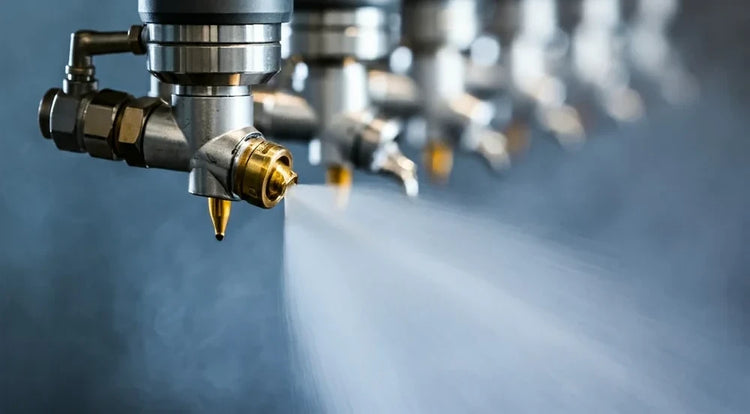Car Wash Detergent Application Nozzles
Effectively applying detergent is the heart of a clean wash. The right spray nozzle optimizes chemical performance, ensures even coverage, and reduces waste — giving customers better results and shorter cycle times.

Why the Right Nozzle Matters
-
Uniform Coverage: Proper droplet size and spray pattern ensure even detergent pick-up without streaks or gaps.
-
Chemical Dwell & Activation: Fine sprays or foam help detergent cling to surfaces long enough to emulsify soils.
-
Reduced Chemical Waste: Better coverage at lower volumes lowers detergent cost.
-
Faster Processing: Optimized flow and pressure shorten spray times and improve throughput.
Typical Application Styles
-
Foam Cannon / Foam Arch: Low-pressure, air-assisted atomizing nozzles create thick, visual foam for branding and cleaning performance.
-
Low-Pressure Fan Jets: Gentle flat-fan nozzles (often 40°–110°) for broad detergent coverage early in the wash sequence.
-
Medium Impact Jets: Narrower flat-fan or cone nozzles for stubborn soils (bugs, tar, brake dust).
-
Metered Soap Injectors: Many systems mix detergent upstream — the nozzle must handle the correct dilution, chemical compatibility, and provide proper spray pressure.
Recommended Nozzle Types & Configurations
| Application Scenario | Recommended Nozzle Type | Typical Notes |
|---|---|---|
| General detergent spray | Flat-fan (40°–80°) | Good coverage, moderate flow |
| Fast dwell foaming | Air-atomizing foam nozzles | Creates cling and visual foam |
| Bug/tar/road film loosening | Narrow flat-fan or full cone (30°–45°) | Higher impact, lower drift |
| Chemical-intensive wash stages | Full-cone or high-impact fan | May require stainless steel or chemical-resistant polymer tips |
Material guidance: Use stainless-steel or corrosion-resistant polymer bodies (e.g. PVDF, PTFE), paired with Viton® or EPDM seals for alkaline or acidic detergents.
Selecting & Sizing Guide
-
Define target detergent concentration & desired coverage: Determine the GPM or L/min needed based on dilution, dwell time, and bay width.
-
Choose spray angle & nozzle spacing: For flat-fans, aim for 50–70 % overlap; use standoff (nozzle-to-vehicle distance) of 6–18 inches (150–450 mm).
-
Verify flow vs. pressure: At the detergent pressure (often 40–80 PSI / 2.8–5.5 bar), measure the actual flow; replace tips if off by ±10 %.
-
Consider effect of chemical viscosity: Thick soaps or gels can reduce flow; choose slightly larger orifice or add anti-drip features to maintain consistency.
-
Install filtration: A 60 – 100 mesh inline filter prevents clogging and ensures consistent spray.
-
Include quick-disconnects and check valves: Speeds maintenance and avoids drips when spray is idle.
Best Practices for Detergent Application
-
Start bottom-up: Spray lower panels first to avoid run-off contamination on freshly treated surfaces.
-
Allow dwell: Let detergent sit for 20-45 seconds (adjust depending on temperature/chemistry) before pressure rinse.
-
Monitor spray patterns: Check for uniform wetting with no pinholes or missed spots; inconsistent sprays often mean worn or misaligned tips.
-
Seasonal adjustment: In colder weather, warm the detergent or increase dwell time slightly.
-
Routine inspection: Monthly check of tip wear and flow consistency (±10 %) ensures reliable performance.
Common Issues & Solutions
| Issue / Symptom | Likely Cause | Recommendation |
|---|---|---|
| Streaking or missed panels | Inadequate overlap or nozzle damage | Adjust nozzle spacing/angle or replace worn tip |
| Excessive chemical use | Overlapping spray or too large orifice | Downsize orifice or reduce pressure |
| Foaming inconsistent or watery | Insufficient air pressure or incorrect foam nozzle | Check air supply, clean/replace foam nozzle |
| Tip clogging | Debris or crystallized detergent | Install or clean inline strainers, flush lines |
| Chemical corrosion or short tip life | Incompatible materials | Upgrade to chemical-resistant materials (PVDF, PTFE, SS316) |
Suggested NozzlePro Products for Detergent Application
-
Flat-Fan Detergent Nozzles (various spray angles)
-
Air-Atomizing Foam/Detergent Nozzles
-
Inline Detergent Strainers & Mesh Filters
-
Quick-Disconnect Adapters & Check Valves
(Contact us to find the exact SKU/orifice code that matches your pump curve and desired detergent usage.)

